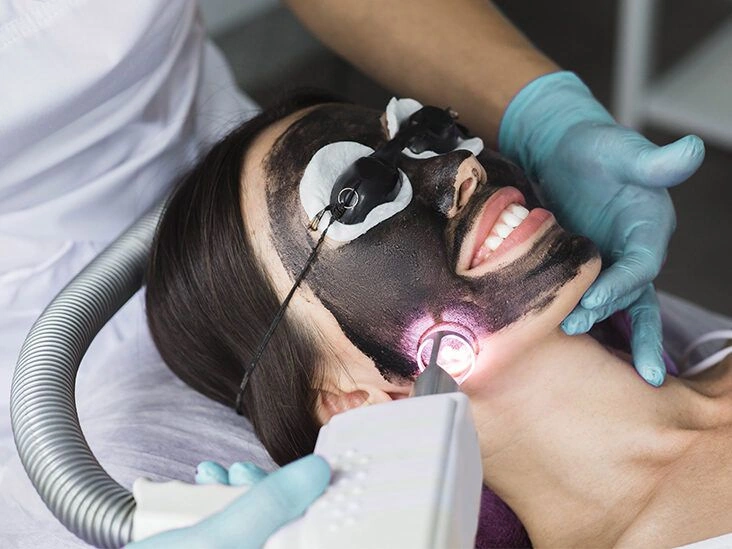The laser carbon peel is a quick, virtually painless treatment designed to enhance the appearance of your skin.
It’s most commonly chosen by people with oily complexions, active acne, and enlarged or clogged pores. This procedure can also help when you begin to notice sun-related damage to your skin.
Laser carbon peels aren’t suitable for everyone. In the following sections, we’ll outline the advantages and effectiveness of this treatment so you can decide if it’s appropriate for you.

What are the benefits of a laser carbon peel?
Laser carbon peels provide deep exfoliation and encourage collagen production.
They are used to address:
- acne
- post-acne pigmentation
- acne scarring
- enlarged and congested pores
- melasma
- photoaging
- fine lines and wrinkles
Chemical peels can also manage these concerns, but here are some key distinctions between the two:
- carbon peels rely on heat rather than chemical agents to achieve results
- carbon peels typically require no downtime
- individuals with sensitive skin or conditions such as eczema often experience less irritation and redness after a carbon peel compared with a chemical peel
How much does a laser carbon peel cost?
On average, a laser carbon peel costs about $400 per session. Because this is a cosmetic treatment, it’s generally not covered by insurance.
Your price will depend largely on the practitioner’s experience, as well as your region and the availability of providers near you.
What’s the procedure for a laser carbon peel?
Schedule a consultation with your doctor or a licensed aesthetician before undergoing the procedure.
Your provider will likely advise you to stop using retinol products about a week prior to treatment, and to apply sunscreen daily during that time.
The laser carbon peel involves multiple steps and usually takes about 30 minutes from beginning to end, which is why it’s sometimes called a lunchtime peel.
Here’s what a typical session looks like:
- The practitioner applies a layer of liquid carbon to your face. The carbon draws out oil, dirt, and dead skin cells from deep within the pores.
- You wait roughly 10 minutes for the carbon to dry.
- Once the carbon has set, you’ll be given eye protection to shield your eyes from the laser.
- The provider glides a laser—often an Nd:YAG—over the skin at a low-energy setting. This heats the carbon, causing it to adhere to the epidermis.
- If you have very reactive skin or darker areas like melasma, your practitioner may recommend avoiding the heating phase. The laser’s heat also reaches subdermal layers, stimulating collagen and reducing the appearance of fine lines.
- At a higher energy level, the laser breaks the carbon into tiny particles.
- A smoke evacuator attached to the device extracts the carbon along with the trapped debris and impurities.
- After the treatment, your provider may apply a hydrating cream and sunscreen to your skin.
You should notice an immediate improvement in radiance and tighter-looking pores.
Those with sensitive skin might experience mild pinkness or redness, which typically subsides within an hour or so.
What’s aftercare like for a laser carbon peel?
Follow these care tips after a laser carbon peel:
- Handle your skin gently after the peel and continue to moisturize daily.
- Some flaking or dryness for a few days is normal.
- Use sunscreen regularly with at least SPF 30 for several days following the procedure.
- Avoid retinol-containing products for at least five days after the peel.
- Do not exfoliate or undergo abrasive or invasive skin treatments for at least one week.
- If you have oily skin, keep using acne-targeted products to help maintain results.
- Consider collagen-supporting products, supplements, or a collagen-boosting diet if you’re addressing photoaging or fine lines.
How effective is a laser carbon peel?
Laser carbon peels are generally very effective for improving oily skin and reducing the appearance of large pores. If you have severe acne or significant acne scarring, multiple sessions may be needed to achieve optimal results. Fine lines and wrinkles can also be noticeably reduced after one or more treatments.
In one case, a young woman with severe pustular and cystic acne underwent six treatments spaced two weeks apart.
She showed substantial improvement by the fourth session, and after the sixth, her acne had decreased by 90 percent. These durable results persisted at a two-month follow-up.
Like chemical peels, carbon peels are not permanent solutions. You may require maintenance treatments to preserve benefits. Carbon peels can be repeated every two to three weeks, which allows sufficient time for collagen rebuilding between sessions.
Everyone’s skin responds differently. Discuss with your doctor or licensed aesthetician how many sessions you might need to see full improvement.
What are the side effects of a laser carbon peel?
Besides mild redness and a tingling feeling, there are typically no side effects from a laser carbon peel.
It’s crucial to have the treatment performed by a qualified, licensed professional to protect your skin and eyes and to achieve the best possible outcome.
The takeaway
Laser carbon peels can revitalize and enhance the look of skin, particularly for those with oily skin, enlarged pores, and acne. Individuals with mild wrinkling and photoaging may also benefit from this approach.
The procedure is painless and requires no downtime. Aside from brief, temporary redness, there are no significant reported side effects.


















Leave a Reply
You must be logged in to post a comment.